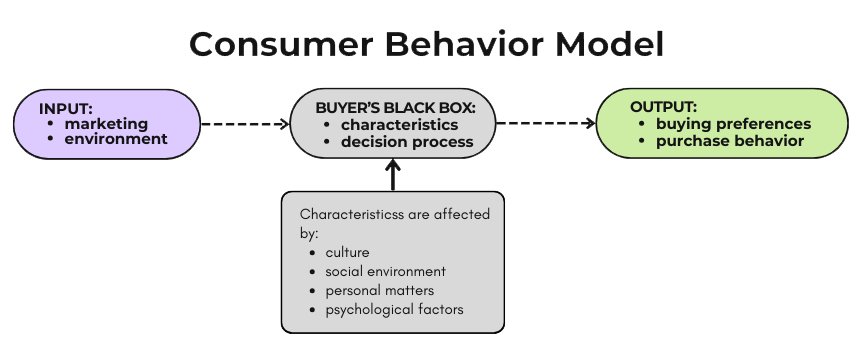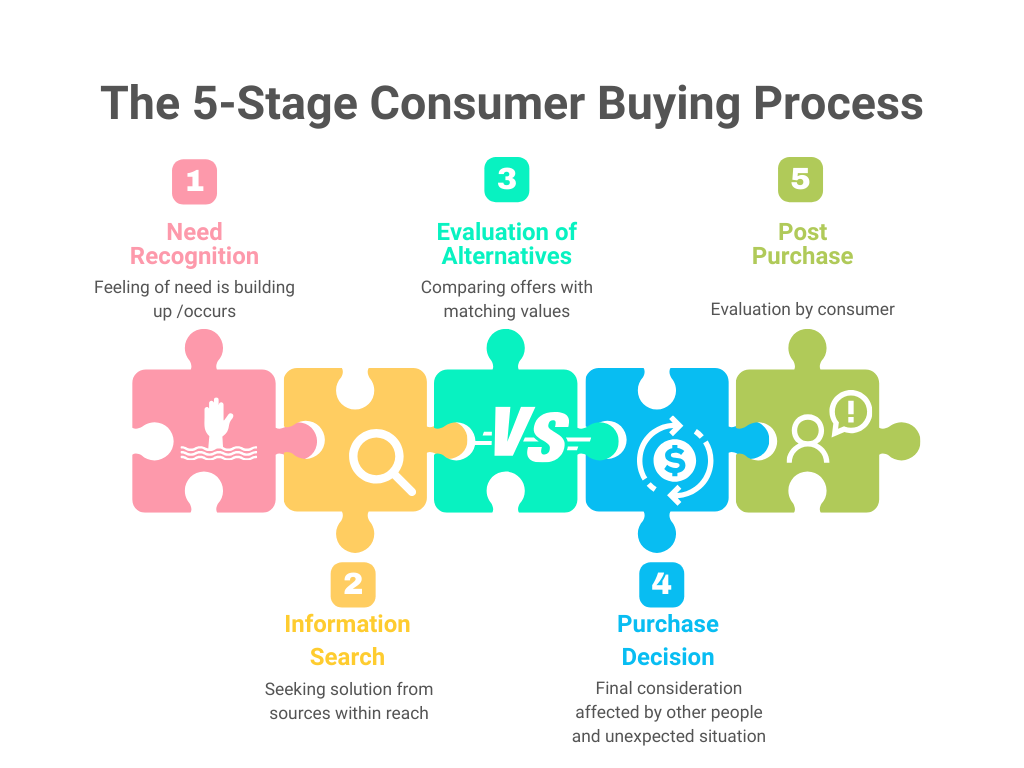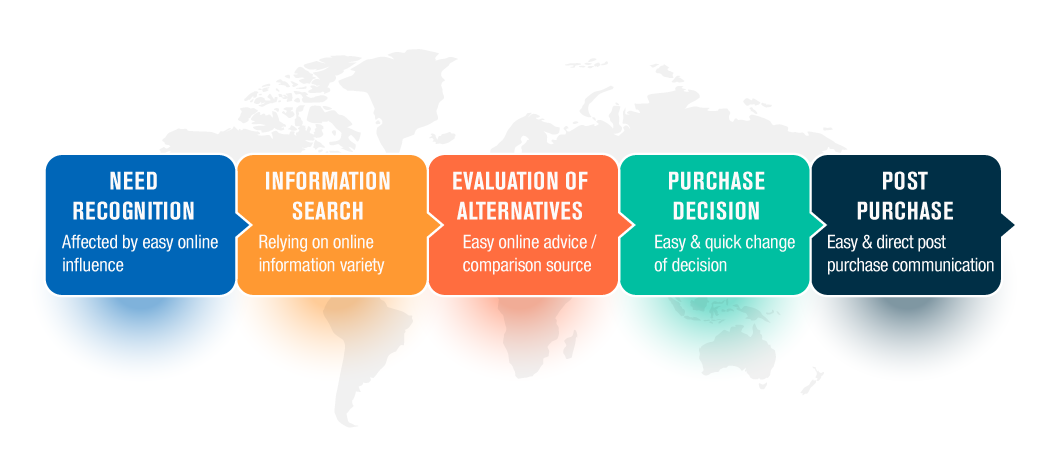Consumer Buying Decision Process - Why They Buy
Follow us at:
This article is about how a consumer arrives at the decision to buy a particular product, what affects them to make the decision and how the process is going. This article presents:
- Introduction to Consumer Purchase Process
- Consumer Behavior Model
- Five Stages of Consumer Buying Process
- Consumer Buying Process in Online Market
- What an Affiliate Marketer Should Do Related to the Process
Introduction to Consumer Purchase Process
A consumer would go through a process before making a purchase decision. But what is in the process? What factors are affecting a person before a decision is made to purchase a specific item? We’ll see how the customer buying process works.
Consumer purchasing decisions are influenced by several factors related to consumer behavior. The consumer behavior is affected by marketing and other stimuli that reach the consumers which result in buyer response.
Before deciding on a purchase, consumers go through a 5-stage process, from recognition, information search, evaluation of alternatives, purchase decision, and post-purchase behavior.
The process is similar between offline and online market. But in the online market, the process goes through digital interactions on electronic devices.
By knowing the details of consumer buying process in online market, an affiliate marketer can improve his chances of making better sales and building consumer loyalty.
We’ll see how consumers act in the 5 stages and what to prepare and what action to take in the stages . The details are described below.
Now first let’s see the consumer behavior model.
Consumer Behavior Model
In the consumer behavior model, there is an input >> process >> output relation. It can be illustrated as follows (from Principles of Marketing, 15th Ed, Kotler) :
What a marketer must find is how the input turns into the output.
Input comes from the marketing efforts from sellers and their environment.
The environment may be economic, technological, social, and cultural.
The characteristics influence how the inputs are perceived. Then a decision process affects his or her behavior.
The characteristics are affected by culture, social environment, personal matters, and psychological factors. The effects vary, which are unique for each consumer. They are described as below.
Culture
Culture is the characteristic features of everyday existence (such as diversions or a way of life) shared by people in a place or time (Merriam-Webster). It encompasses values, perceptions, wants, and behavior. Culture is are formed by the life experience and environment a person has gone through. This includes subculture (a smaller group of people with shared value system) and social class (society’s divisions with similar values, interest, and behavior).
Social environment
The social environment is the space where a person shares similar values, interest, and behavior, and habit. This includes groups and social network where people of the same interest interact. Family members have influence too. Family relationship is one of the strongest effect on a buying decision. An advice from a family member, especially the one considered more senior or experienced or dependable, usually has very strong influence on consumer purchase decision.
Another factor in social environment is the roles and status, where a person’s preferences usually reflect his position in a society.
Personal matters
Personal matters include age and life-cycle stage (tastes that change with age), occupation, economic situation, lifestyle, and personality (a person’s unique characteristic that distinguish him or her, which also includes brand personality – how a person tied to a personal brand).
Psychological factor
Psychological factor includes motivation, perception, learning, beliefs and attitudes.
Motivation is what drives a person so satisfy his needs. The motivation can be biological (such as hunger) or psychological (such as the need for recognition).
The psychological motivation can be really strong. A person can buy something that he does not totally understand about or actually need, but he wanted it so badly, such as something related to his hobby. For example: a person buying an expensive bicycle just because he loves riding.
Perception is what influence an act. It is how a person senses and assesses a specific situation. For the same problem, a person’s perception can differ due to different moment. Perception is also subjective to every person, even for the same situation.
For example: One person may see a road bicycle as fit for tackling a route, while another may see it not fit, even though both riders have ridden together for some time.
Learning effect occurs when a person learns from previous purchase experience or use. The experience will fortify the certainty toward certain decision. The learning may bring the decision toward a certain product weaker or firmer.
The result of learning an can also be affected by whether the experience came with sacrifice (bought using own money) or without spending (such as a work equipment from a company). Usually the result will be firmer and explicit if it was a purchase with own money.
Belief and attitude
Belief is what a person thinks about something. This may be exact, real, or emotional. The beliefs build product and brand images about products. For example: driving a bigger vehicle makes some people think they are safer on the road, which can be true, and can also be untrue.
Attitude describes a person’s evaluation, feeling or tendency toward an object or idea. This will lead to like and dislike. Attitude is difficult to change.
Now we come to the stages in consumer buying process.
Five Stages of Consumer Decision Making Process
There are five stages in consumer decision making process. They are: need recognition, information search, evaluation of alternatives, purchase decision, post-purchase decision.
1/5 Need recognition
Need recognition is when a person recognizes a need or problem. Need is a feeling of deprivation when something not fulfilled. It can come from a natural need or from external factor such as seller marketing promotion.
Marketers should learn about what consumer need to satisfy. They must be cautious because what the consumers really need may be different from what the marketers think. A customer may ask for a drill bit, while actually he needs a hole on a wall. The hidden question is “what kind of hole is needed?”.
2/5 Information search
Consumers will look for information about solution to the need. They will seek information from sources within their reach. This could be from people (non-media sources), and can also be from media (conventional or digital), or from experience.
Each information source has different strength in affecting the consumer purchase decision. The effect on presentation of information vary among target market. It can also vary even only by exposure time.
For example: TV ads for children toys may not be effective if broadcast late at night.
A note though: personal information source can be the strongest. An advice from a person close to a consumer is often more trusted than a marketer’s ad. For example: A father’s advice such as “I’ve tried and tested it since you were a baby” can be more trusted than whatever any TV ad says.
3/5 Evaluation of alternatives
After finding information on alternatives, consumers then choose among the alternatives. Sometimes consumers make careful comparisons, sometimes they don’t. Sometimes they use intuition. They may also make decisions by relying on other people, reviews, or other advices.
For an evaluation, consumers usually will set a list of requirements, features or benefit offered by the alternatives. They will then determine which of the aspects will be prioritized or compromised. For example: a car buyer may choose a specific vehicle brand by prioritizing reliability feature if in their perception the brand is tied to such feature, and their priority is reliability instead of say, price.
The evaluation is also subject to change to many factors, and it is even situational. A decision made after a long consideration for product alternatives can change quickly due to immediate situation. For example: A consumer may grab whatever medication available at the nearest drugstore in case of an emergency medical condition, even if the consumer actually does not prefer the product.
When a consumer is deciding a product to purchase, the consumer may be affected by two factors: attitude of other people and unexpected situational factors.
As discussed in the social environment aspect above, an advice from a trusted or honored person, or a family member can change the buying intention of a consumer.
Unexpected situational factors can also make the intended decision to change. These can be a sudden change of budget, change of product price, market promotional activity, or arrival of new competitor products. In general, the unexpected situations are those that can quickly change the price-vs-benefit perception by the consumer.
Thus the carefully prepared purchase intention does not always result in actual purchase of intended product.
5/5 Post purchase behavior
Product use will result in satisfaction or dissatisfaction. This is a result of how much expectations of the consumers are met. This can also be seen as how good the product meets its promise. Thus marketers should be careful not to promise anything that is impossible to meet.
The post purchase behavior is where customer satisfaction becomes a prominent factor. After the purchase, consumers may share their experience with the product or serviced. If their expectations are met, they may praise the purchase and the product. If they are disappointed, they may present complaints.
The satisfaction of expectations will place the chosen product at a favorable position among competing products. This will generate a tendency of repeat purchase or buying other products from the same company. Moreover, the satisfaction will increase the company’s credibility in the eyes of the consumer (which at this point, is a customer).
On the other hand, dissatisfaction works in the other direction. A disgruntled customers will be bad publication for a producer or company, tainting the product’s or company’s image.
And also need to be remembered, the satisfaction or dissatisfaction often result from expectations which are frequently non-exact, difficult to measure.
Consumer Process in the Online Market
In the online market, all the processes consumers going through are mostly endured in digital way, which is through digital devices.
As discussed in the Getting to Know the Online Market article, reaching customers, transactions, and post transaction activities occur online. The process that shapes consumer’s perception also mostly happens online. The inputs received by consumers, and the factors that affect the final purchase decision occur through digital, two-way communication media. Even social environment and personal matters are going on Internet pathways.
A marketer should pay attention on the online factors that have effect on the consumers related to what will lead the consumers into satisfying his or her need through online communication media. An online marketer should learn in which point he can optimize an affiliate site role along the customer digital purchase process.
An example is the social environment. It is easy to create online social groups compared to offline groups. Thus now there are tons of online groups to share similar interests.
Influence in family social group is also changing. With online group,
influence of a dominant family group member now has greater effects, with more instant response among the members.
Here are some of the stages of consumer buying process as they happen in an online market.
Marketing
Sellers reach consumers through digital devices. The marketing stimuli (product, price, place, promotion) affect the consumers through digital pathway. Digital marketing efforts are more focused, direct, cost-effective, more efficient, and can be interactive.
Environment
The digital era bring impact mostly on technological, social, and later, cultural aspects of consumer environment. One significant aspect is the ‘instant’ response culture which is building quickly among consumers.
Consumer Buying Process Stages in the Online Market
The five stages of consumer buying process in the online market take digital pathways compared to the conventional market. Some unique properties of the stages in the online market are:
Need recognition in online market
During need recognition, marketing promotion /ads have significant effect. Consumers will sharpen /fine tune their need from information they find online. In the online market, promotion can becomes more focused, direct, and can be more customized even to near personal needs.
Information search
The digital market is where a vast freedom and total convenience for information search. Consumers have a lot of (even too much) sources of information and interactions during their search for information.
The drawback is quality of information. Since it is also very easy to put information on the Internet, information quality varies wildly. This is where junk and top quality information mix. Unaware customers may be led to believe in wrong information instead of the right one.
Evaluation of alternatives
The digital world also makes it much easier for consumers to perform evaluation of alternatives. They can easily switch between details of alternative products in fraction of time compared to conventional market purchase process. If sellers are not careful with their offer, price can be the only weapon left and sellers can be trapped in a suicide ‘price war’.
Purchase decision
In the online market, consumers usually make a decision quickly with less hesitation and less deep consideration as the conventional market . It is an easy ‘just do it’ ‘ready at the fingertip’ purchase action. While it is quick to confirm a purchase, the distractions from other sellers or offers are often galore.
During the purchase process, there are also opportunities for other offers from the seller.
Post purchase
In the digital market, a customer can easily describe his or her experience of the product. The consumer may tell whether the product is favorable or failing to meet expectations. The difference with conventional market is that this is done much easier, the audience is much wider. The customers may not only communicate with the seller or producers, but also with other people at any place.
Online transactions usually leave tracks or are made using the customer’s account. This enables easy communication with the customer, which can be beneficial for both the customer and the seller. For example: the seller can get input from actual customers about the product to help improve it in the future.
What an Affiliate Marketer Should Do Related to the Process
So how do we apply this process in affiliate marketing? Here’s what we can do during each stage of the process.
During need recognition
Affiliate marketing efforts can take action in form of marketing promotion. With digital media, an affiliate marketer (or its seller) can design a more detailed and focused promotion which promotes more competitive value offering to target consumer. For example: using video to clearly show extra feature other competitors don’t have.
During information search
An affiliate marketer can design a more customized information to answer the questions of the consumers. Due to its natural property of small businesses, an affiliate marketer can quickly adapt and respond to consumer’s new requirement.
Affiliate marketers can respond to more specific questions rather than big businesses can do. This can help to make customers feel closer to them. And as a unique seller, each affiliate marketer can present different points of view on consumer’s needs. Thus every seller can offer unique benefits for the consumer’s needs.
A good example is preparing a response for specific questions with guarantee to respond within specific time (say within 24 hours).
During evaluation of alternatives
With handheld devices such as handphones, making comparison of available offers is now very easy for customers. The customers can easily search for advices and suitable solution alternatives for their need.
While a marketer still needs to deal with understanding what the consumer actually needs, they must present their offers to suit the search method consumers use. Not only the affiliate marketer must be able to see from the consumer point of view, his offer (the affiliate site) must also be tuned to ‘pop out’ during in search performed by the consumer. To do it, the marketer needs application of SEO (search engine optimization).
Not only showing up as consumer solution search result, a marketer must also distinguish himself from others. An affiliate marketer must be able to make the consumer believe that the affiliate site is the most suitable, trusted, and uniquely enjoyable for the consumers to find solutions at.
Communication skill becomes important in this process. Not only able to answer ‘consumer need’, a marketer (and the marketer’s website) must also make the consumer feel comfortable and easy when visiting the affiliate site.
As affiliate marketer relies on website, an easy to navigate, consumer-centered website is recommended. Product explanations or descriptions must be able to provide answers to customer’s questions. Clear, relevant graphics or videos are good features to present information.
Another significant website feature is the CTA (call to action). A page with ‘call’ to the customer to execute a purchase is a good way to prevent the buyer from ‘going astray’ to other sellers.
During purchase
The purchase is the time when a buyer becomes a customer. It means that it is where the transaction plays major role in building a customer relationship. Thus the seller or marketer must make sure that the transaction will go smoothly. For an online seller, it is also the opportunity to present other offers. Furthermore, a seller can also collect a customer database and build customer profile at this stage.
An affiliate marketer should make sure that the setup for a purchase transaction is set correctly, such as the product advertisement and link. An affiliate marketer can also present other accessory or related product offers after the transaction.
In post purchase
After the purchase, a customer may also give a response concerning the product, which can be a praise, product use, concern, or complaint. An affiliate marketer must also prepare for such communication because the affiliate marketer is the one that provides ‘lead’ to the product. This is also an opportunity to build and maintain a customer relationship.
In the communication to maintain the customer relationship, the marketer must also have a way to forward the message (when necessary) along the marketing channel, upward to the store or producer about the message from the customer (see article about Marketing Channel here). Therewith affiliate marketer should always try to maintain his affiliate site or channel as trusted, distinguished, and loved by his customers.
Thus we have seen how the consumer purchase process works, the involved stages, and what an affiliate marketer can do in each stage to improve his business.
Thank you for reading. I hope this article will be useful. Just leave a message or comment if you want to. See you in another article.
Follow us on X, facebook, and twitter:





